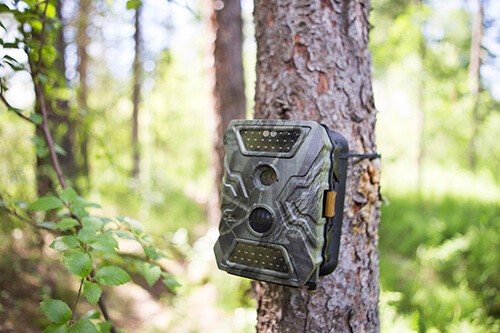Trail cameras not just for wildlife anymore
Aug 10, 2020

Ever deal with trespassing on your farm, hunting property, or home? It’s a safe bet that most of us have. Some folks seem to ignore the “private” part of the words “private property,” unfortunately.
There is, however, a device that can certainly come in handy to monitor such un- scrupulous activity, one that many of us already possess: a trail camera. Yes, most people associate these cameras with recording photos and videos of the trophy deer or other wildlife, but their use goes far beyond that.
Off the Trail
A trail camera can also be an economical means of security.
For example, a farmer can place a camera on the roof of a barn or tool shed or on a gatepost to monitor activity on the farm. A homeowner can strategically camouflage a trail cam from a tree or in a bush or think outside the box by mounting the camera on a bird feeder or in a window. Trail cameras work similarly to home security systems in that they both use motion sensors.
Trail cameras for security come in many configurations with a variety of programming options. In addition to taking still photos and video, many capture audio of the video feed. If you have a problem with trespassers, there are two types of trail cameras that do an excellent job of surveillance:
Cellular/Wi-Fi Trail Cameras
Cellular/Wi-Fi cameras have the ability to take a picture and immediately send it to your cell phone or email. Cellular cameras work on certain networks, such as Verizon or AT&T, while Wi-Fi cameras produce their own wireless network to provide real-time access to the comings and goings of any unwelcome visitors.
This is especially valuable if you have a trespasser who takes off with your camera because even if it’s stolen, you’ll have the photos/ videos in your possession.
No Glow Cameras
No Glow cameras, also commonly referred to as blackout trail cameras or invisible flash trail cameras, illuminate an on-camera subject without the subject detecting the flash by using infrared (IR) flash. No Glows are popular for wildlife surveillance because they don’t spook game like other types of trail cameras, so naturally their effectiveness translates well for farm and home security.
Other Tips
Before placing your camera at a desired location, test it first. Make sure the time stamp option is turned to “on.” This lets you know the exact time and date of the activity, which could be used as evidence should law enforcement need to be involved.
Another helpful tip is to find areas that are shady or let in just enough light to clearly capture photos. If your camera directly faces an area with too much light, it can create a glare that results in images that are too bright and, ultimately, unusable.
Many participating Co-ops carry a variety of trail cameras to best fit your needs. Let us help you find the right solution!
There is, however, a device that can certainly come in handy to monitor such un- scrupulous activity, one that many of us already possess: a trail camera. Yes, most people associate these cameras with recording photos and videos of the trophy deer or other wildlife, but their use goes far beyond that.
Off the Trail
A trail camera can also be an economical means of security.
For example, a farmer can place a camera on the roof of a barn or tool shed or on a gatepost to monitor activity on the farm. A homeowner can strategically camouflage a trail cam from a tree or in a bush or think outside the box by mounting the camera on a bird feeder or in a window. Trail cameras work similarly to home security systems in that they both use motion sensors.
Trail cameras for security come in many configurations with a variety of programming options. In addition to taking still photos and video, many capture audio of the video feed. If you have a problem with trespassers, there are two types of trail cameras that do an excellent job of surveillance:
Cellular/Wi-Fi Trail Cameras
Cellular/Wi-Fi cameras have the ability to take a picture and immediately send it to your cell phone or email. Cellular cameras work on certain networks, such as Verizon or AT&T, while Wi-Fi cameras produce their own wireless network to provide real-time access to the comings and goings of any unwelcome visitors.
This is especially valuable if you have a trespasser who takes off with your camera because even if it’s stolen, you’ll have the photos/ videos in your possession.
No Glow Cameras
No Glow cameras, also commonly referred to as blackout trail cameras or invisible flash trail cameras, illuminate an on-camera subject without the subject detecting the flash by using infrared (IR) flash. No Glows are popular for wildlife surveillance because they don’t spook game like other types of trail cameras, so naturally their effectiveness translates well for farm and home security.
Other Tips
Before placing your camera at a desired location, test it first. Make sure the time stamp option is turned to “on.” This lets you know the exact time and date of the activity, which could be used as evidence should law enforcement need to be involved.
Another helpful tip is to find areas that are shady or let in just enough light to clearly capture photos. If your camera directly faces an area with too much light, it can create a glare that results in images that are too bright and, ultimately, unusable.
Many participating Co-ops carry a variety of trail cameras to best fit your needs. Let us help you find the right solution!